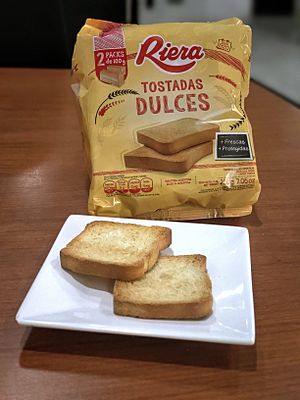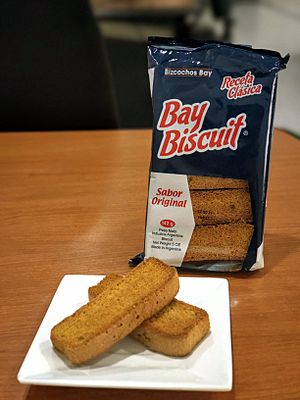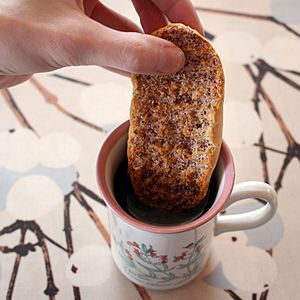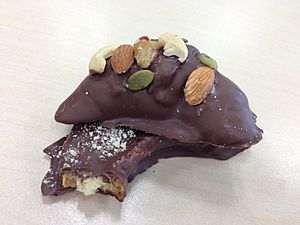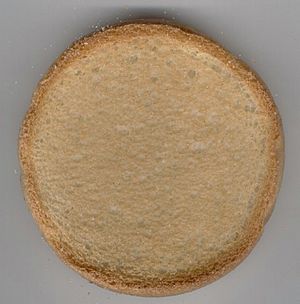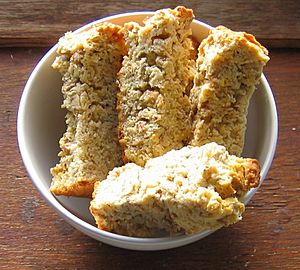Rusk facts for kids
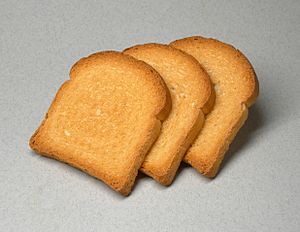
German Zwieback
|
|
| Type | Biscuit |
|---|---|
Imagine a super crunchy biscuit or a piece of bread that's been baked twice! That's a rusk. Sometimes, rusks are even made from cake, and we call those cake rusks. Babies sometimes chew on rusks when their teeth are growing, as they are hard and safe. In the UK, 'rusk' can also mean a special ingredient added to foods like sausages.
Rusks Around the World
Rusks are popular in many countries, but they have different names and styles!
Argentina
In Argentina, rusks are called tostadas de mesa, which means "table toasts." They are slices of bread baked twice. You can find them in stores, and they come in plain or sweet versions. Cake rusks are known as bay biscuit and are made with eggs, sugar, oil, flour, and vanilla.
Azerbaijan
In Azerbaijan, rusks are called sukhary. This name comes from the Russian word for them. They are often made from old bread or buns. Bakeries in Baku sometimes make sukhary from their leftover bread to avoid wasting it. This makes them very affordable.
Bangladesh
In Bangladesh, rusks are commonly called "Toast Biscuit." People usually enjoy them with a cup of tea.
Britain
In Britain, a type of rusk called "butcher rusk" is used in the food industry. It's a dry biscuit broken into small pieces. It helps bind ingredients in foods like sausages and hamburgers. It also helps carry flavors and colors in food.
Farley's Rusks
Farley's Rusks are a special dry biscuit for babies in the UK. They have been around since the 1880s. Parents often give them to infants soaked in milk, or as a hard snack to help with teething.
Cuba
Sponge rusk in Cuba is like biscotti, but it's made from yellow cake batter that's baked twice. The cake is first baked flat, then sliced into strips, and baked again until it's toasty. People often eat it with Cuban coffee or as a side with ice cream or other desserts.
Denmark
In Denmark, rusks are called tvebak. This name comes from a Dutch word that also means "two bake," just like how rusks are made!
Finland
A Finnish rusk is called korppu. It's usually a dried piece of bun with cinnamon and sugar. People often dip korppu in coffee before eating it. There's also a sour version called hapankorppu, which is a flat rusk made from rye flour and salt, eaten like crispbread.
France
The French version of rusk is called biscotte. You can easily find them packaged in supermarkets.
Germany
In Germany, rusks are known as Zwieback. This name literally means "twice baked," which describes how rusks are made.
Greece
In Greece, rusks are called paximadi. They come in many forms and are often made from barley or chickpea flour. Before eating, they are usually softened with wine, water, or oil. Paximadi is the main part of a famous Cretan snack called dakos.
India
In India, rusks are a traditional dried bread or cake. They are also known by names like papay, rattan, khasta, russ, or "cake rusk." In Tamil, they are called "porai." People usually dip them in milk tea to make them soft before eating. The sweet "cake rusk" is made from cake ingredients like wheat flour, sugar, and eggs.
Indonesia
In Indonesia, double-baked bread is called "bagelen." It's thought to come from a village called Bagelen in Central Java. Before the second bake, the bread is spread with sugar and buttercream. It's often eaten as a snack.
Iran
In Iran, rusk is called nān-e sokhāri. It's made from wheat flour, sugar, milk powder, and other ingredients. People eat it by dipping it in Persian tea. Vitana is a very common brand of naan sukhaari.
Italy
In Italy, this type of rusk is called fette biscottate. It's different from biscotti, which are twice-baked cookies. Italians also have cantucci, which are hard, crunchy, almond-flavored biscuits. They are often dipped in coffee, dessert wine, or a strong drink called grappa.
Japan
In Japan, rusks are often seen as a special treat. They can be made from baguette, cake, or croissants and are usually sweet.
The Levant
In the Levant (a region in the Middle East), rusks are called boksum in Iraq and Syria, and qurshalla in Jordan and the occupied Palestinian territory. They are made with flour, eggs, oil, sugar, and sometimes cardamom. They are often topped with roasted sesame seeds or caraway seeds and eaten by dipping them in herbal tea.
Netherlands and Belgium (Flanders)
Beschuit are light, round, and crumbly rusks eaten in the Netherlands and Belgium. When a baby is born in the Netherlands, it's a tradition to serve beschuit met muisjes. This is beschuit topped with "little mice," which are anise seeds covered in pink and white or blue sugar, depending on if the baby is a girl or boy. Beschuiten are also eaten for breakfast with toppings like butter and chocolate sprinkles, jam, or cheese. A favorite is serving strawberries on beschuit with sugar or whipped cream.
Beschuiten are made by baking a flat round bread first, then slicing it in half, and baking each half again. They are usually sold in rolls of 13 rusks. The names biscotto, biscuit, and beschuit all come from a Latin phrase meaning "bread, twice cooked."
Norway
In Norway, rusks are called kavring, similar to the Swedish skorpor. Crushed kavring, called strøkavring, is used in dishes like kjøttkaker (meatballs) and a traditional dessert called tilslørte bondepiker. Kavring can also be broken up and served with milk.
Pakistan
In Pakistan, rusk is commonly known as Russ. It comes in round shapes, like a bun, or as separate rectangular pieces. It's a popular breakfast food, often dipped in milk tea (called doodh chai) to make it soft. Cake rusk is called papay in Punjabi.
Philippines
The Philippine version of rusk is called biscocho. Cake rusks are known as mamon tostado.
Portugal
The Portuguese version of rusk is called tosta. Tosta are hard, coarse slices of bread. They can be sweet or savory and come in different shapes and thicknesses. They are often ground up and used as bread crumbs.
Russia
The Russian version is called sukhar' (сухарь). This word comes from "сухой," meaning "dry." They are either baked a second time from sweet bread, sliced like biscotti, or made from leftover stale bread cut into small cubes and dried. The sweet ones are like cookies, eaten with milk, tea, or coffee. The other kind is often added to soup, where it softens up and is eaten instead of bread. This tradition helps avoid wasting bread, which is very important in Russian culture. Rye bread rusks are also a main ingredient in making Kvass, a traditional fermented drink.
South Africa
In South Africa, rusks are called beskuit. They are a traditional breakfast or snack for Afrikaner people. Rusks have been made in South Africa since the late 1600s as a way to keep bread fresh, especially for long journeys without refrigerators. They were important during historical events like the Great Trek and the Boer Wars. Today, people usually dunk rusks in coffee or tea before eating them.
How Rusks Are Made
Rusks are basically bread dough that's baked twice. Round balls of dough are packed closely in pans and baked like bread. After that, long pieces are cut or broken off and slowly baked again until they are dry and crunchy. Many modern rusks are made in factories, with Ouma Rusks being a very famous brand. Many bakeries also sell rusks, sometimes with different ingredients like baking powder instead of sourdough. Besides plain and buttermilk flavors, you can find rusks with anise, whole grains, condensed milk, muesli, and lemon poppy seeds.
Local Traditions
In South African homes, rusks are often offered to guests as a treat, usually with a cup of tea or coffee. Many South Africans enjoy rusks for breakfast or as a snack any time of day. Because rusks are hard, the tradition is to dunk them in tea or coffee before taking a bite. This is a very special tradition for many South Africans.
Sweden
Skorpor (plural; singular skorpa) are a Swedish type of rusk. They are usually plain or flavored with cardamom, but can also have herbs, dried fruit, nuts, or spices like anise. The Swedish bakery company Pågen makes Krisprolls, which are the most-sold rusk brand in the world. The traditional way to eat them is by dipping them into a drink like coffee, milk, or juice. You can also put butter and possibly cheese, marmalade, or jam on top and eat them with a drink or fruit soup.
Rusks have been known in Sweden since at least the 1500s. They were used as food for soldiers and on ships. Back then, they could also be crushed into crumbs and added to drinks like svagdricka (a type of weak beer) or soup.
Turkey
In Turkish, rusk is called peksimet. "Pek" means solid or durable in Turkish, and "simet" is an Arabic word for bread or flour. Another name for it is galeta.
United States
In the US, common types of rusk include melba toast and croutons. These are sold in grocery stores. Biscotti are also a type of rusk found in stores and coffee shops.
Images for kids
See also
 In Spanish: Biscote para niños
In Spanish: Biscote para niños


